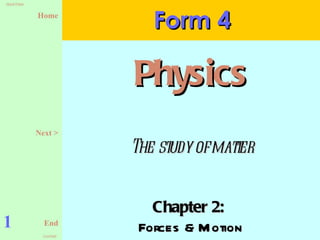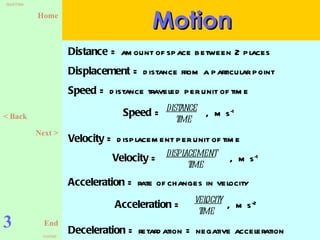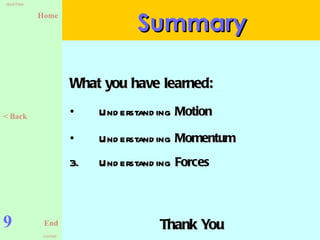Physics form 4 chapter 2
- 1. Chapter 2: Forces & Motion Form 4 1 Physics Next > The study of matter
- 2. Objectives: ( what you will learn ) 1) understanding Motion 2) understanding Momentum 3) understanding Forces Physics: Chapter 2 2 < Back Next >
- 3. Motion 3 Distance = amount of space between 2 places Displacement = distance from a particular point Speed = distance traveled per unit of time Velocity = displacement per unit of time Acceleration = rate of changes in velocity Deceleration = retardation = negative acceleration < Back Next > Speed = distance time , m s -1 Velocity = displacement time , m s -1 Acceleration = velocity time , m s -2
- 4. 4 Motion Equations of motion: Inertia = tendency of things to resist changes in motion Momentum = mass x velocity Law of Conservation of Momentum When 2 or more objects act upon each other, their total momentum remains constant; if no external forces are acting. Impulse = changes in momentum = mv â mu = Ft Impulsive force = rate of change of momentum (in a collision or explosion) < Back Next > v = u + at v 2 = u 2 + 2 as s = ut + Â― at 2
- 5. 5 Newtonâs Law Newtonâs First Law Every object continue in its state of rest or motion in straight line, unless it is compelled to change by forces acting on it. Newtonâs Third Law Whenever an object exerts a force on a second object, the second object exerts an equal and opposite force on the first. 2 < Back Next > Newtonâs Second Law The acceleration of an object is directly proportional to the net force acting on the object, in the direction of the net force, and inversely proportional to its mass. F = ma 1 F 1 F 2
- 6. 6 Forces & Motion Free fall = motion under the influence of gravitational pull only. The acceleration of free fall is g . Earthâs gravitational field strength ( g ) is 10 N/kg. Weight is the force due to gravity on an object. Weight ( W ) is the product of mass ( m ) and acceleration due to gravity ( g ). W = mg Forces in equilibrium = balanced forces = resultant force = 0 (The acceleration of the object is zero) Unbalanced forces = single force = resultant force Work = force x distance Unit is kg m 2 s -2 or Joule (J) < Back Next >
- 7. 7 Forces & Motion All moving objects have kinetic energy (KE) which is due to motion. KE = Â― mv 2 Gravitational potential energy is the work done when an object dropped because of downward gravitational pull. PE gravity = mgh PE elastic = Â― Fx Elastic potential energy is work done to stretch or compress a spring or a rubber. Law of conservation of energy Energy cannot be made or destroyed, but can change from one form to another. < Back Next > Efficiency = Useful energy output Energy input X 100%
- 8. 8 Forces & Motion Power = rate at which work is done (unit in watt, W) Elasticity The property of changing shape when a deforming force acts on an object & returning to the original shape when the force is removed. Hookeâs Law The amount of stretch or compression is directly proportional to the applied force, F. < Back Next > Power = Work done Time taken
- 9. 9 Summary < Back What you have learned: Understanding Motion Understanding Momentum Thank You 3. Understanding Forces








